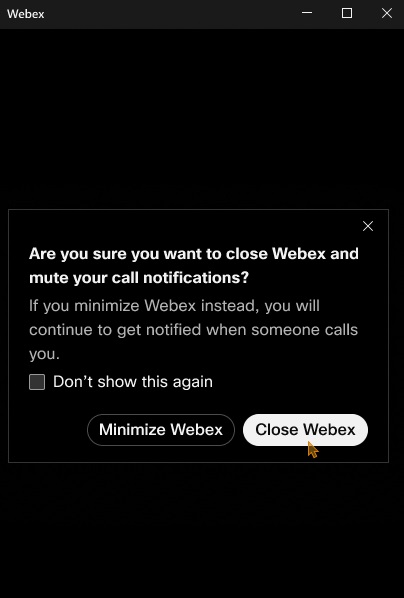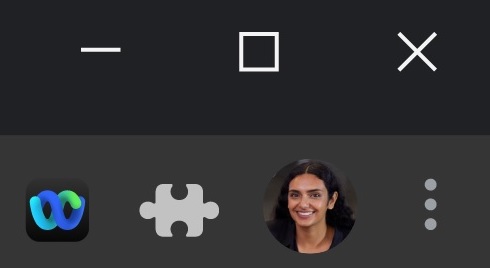- Home
- /
- Article

Webex Calling for Chrome
 In this article
In this article Feedback?
Feedback?As a Webex Calling user, you can be productive while working in Google Workspace by placing calls directly from the Google Chrome browser, without the need for a separate desktop application. Webex Calling for Chrome is available as an extension in the Google Chrome Web Store. Webex Calling for Chrome delivers a powerful suite of enterprise calling features through an intuitive, browser-based softphone.
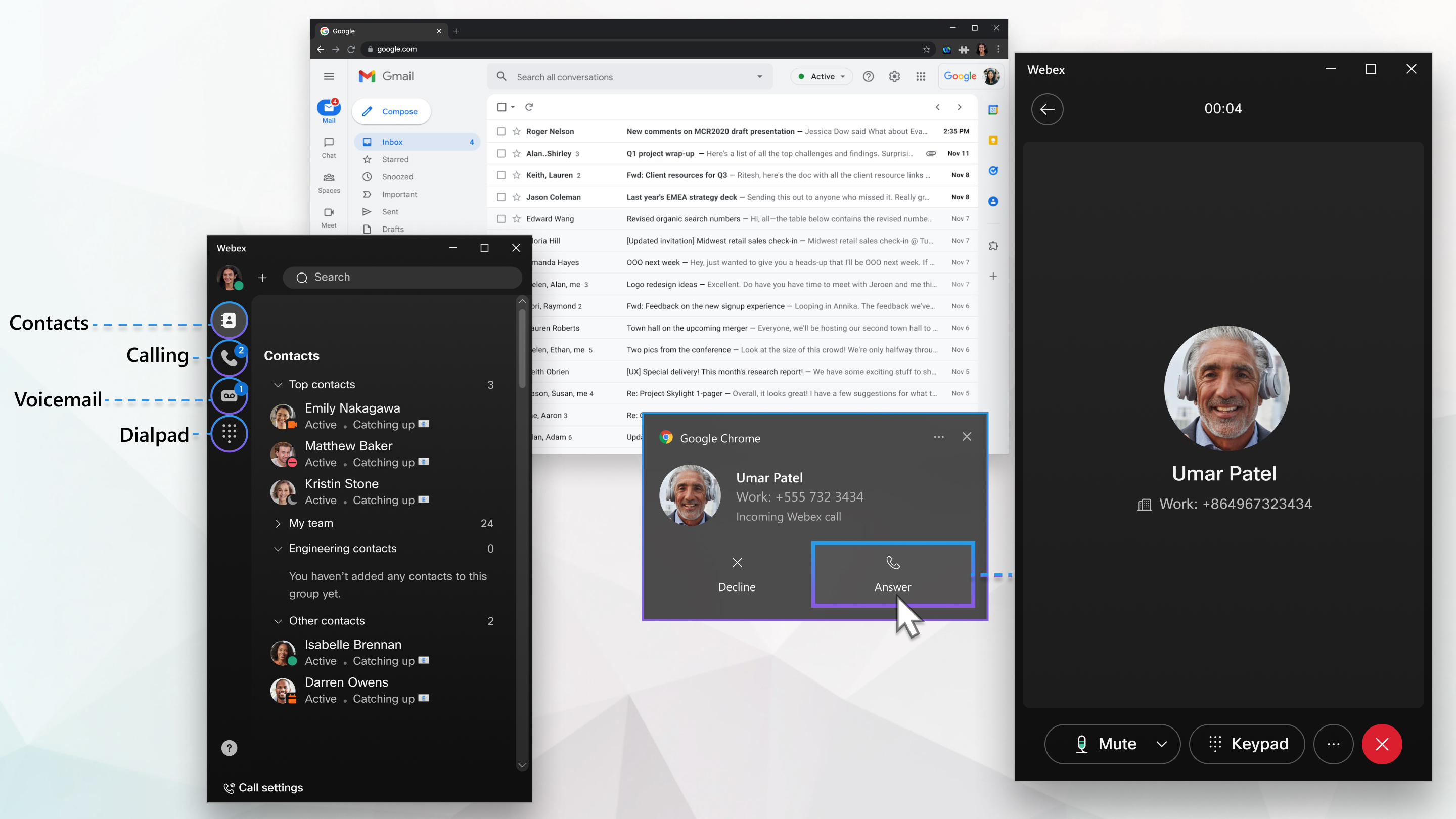
Prerequisites
Webex Calling for Chrome is available to all Webex Calling users with a Professional license. Visit the Chrome Webstore and search for Webex Calling for Chrome to add it as an extension into your Chrome and Edge Chromium browser. The extension works on desktop operating systems that support Chrome and Edge Chromium. The following operating systems are supported:
-
Windows 10 and above
-
Mac OS version 11 Mountain Lion (or later)
-
ChromeOS
-
Linux Ubuntu, 22.04.2 or higher
Calling features
Webex Calling for Chrome supports the following calling features:
-
Incoming and outgoing calls
-
Search for a user in the corporate directory and call from the search results
-
Outgoing call from the keypad
-
Click to call a phone number from any Google workspace application and Chrome web page
-
Receive inbound call notifications in the web client
-
Call hold and resume
-
View history of placed, received, and missed calls from call history
-
Call transfer—Consult first and transfer now
-
Voicemail with message waiting indication (MWI) and transcript in the client
-
If you have a Webex Calling Professional license, you can now use Webex Calling directly in Chrome.
Limitations and restrictions
The following are the known limitations and restrictions of Webex Calling for Chrome:
-
Calling from the web client uses the system's audio input and output devices. The user cannot select a specific device from the client. If you have multiple devices, for example, a docking station with a monitor, then you must select the audio input or output device of the monitor in the OS settings (such as, Windows settings).
-
You can have only one browser client connected to Webex Calling. If you sign in from another instance of the client, you are signed out from the earlier session.
-
Web client users in India can’t make or receive PSTN calls.
-
For administrators only: If you are using Control Hub to view analytics for Webex Calling for Chrome, the endpoint type within the Call Legs by Endpoint Type section of the Calling Media Quality dashboard displays as Unknown.
The browser application type counts against the per-user limit of 35 shared line appearances. If the Webex Calling for Chrome extension fails to register to Webex Calling, have your administrator do the following:
-
In Control Hub, go to .
-
Check the Web check box.
-
If Web is unchecked, remove some shared line associations.
If you are using an older version of the Webex Call extension, we recommend that you migrate to the Webex Calling for Chrome extension.
Before you begin
You must use the Chrome browser version 104 or later to use Webex Calling for Chrome.
| 1 |
Go to the Google Chrome web store and search for Webex Calling for Chrome. |
| 2 |
Click Add to Chrome. |
| 3 |
Click Add extension. |
| 4 |
(Optional) Pin the extension to the browser tab. |
| 1 |
Click |
| 2 |
Enter your email address and click Next. |
| 3 |
Enter your account password and click Sign in. Once you sign in to Webex Calling for Chrome, you can see your number in the footer. |
There are several ways to make a call using the Webex Calling for Chrome.
To call someone, click one of the following menu options:
|
Menu |
What to do |
|---|---|
|
Keypad |
|
| Calling |
|
| Click-to-call |
|
There are two ways to transfer a call—Consult First and Transfer Now (known as blind transfer). You can transfer an incoming or outgoing call to another number using Transfer.
To transfer a call, follow these steps:
| 1 |
Place a call or answer an incoming call. |
| 2 |
From (…), select Transfer. The caller is placed on hold while transferring the call to the intended recipient. |
| 3 |
Find or search for the intended recipient during Consult First or Transfer Now using one of the following methods:
|
| 4 |
Click Transfer Now or Consult First. |
| 5 |
If you selected Consult First, wait for the recipient to answer the call. Unanswered calls are forwarded to voicemail. |
| 6 |
Once the intended recipient answers the call, click Complete Transfer. After the call transfer, Webex Calling for Chrome displays the initial screen. |
| 1 |
Answer the incoming call. |
| 2 |
From (…), select Hold. The caller stays connected, but you can't communicate with them until you resume the call. |
| 3 |
Click Resume to resume the call. |
Enable notifications in your operating system and in your Chrome browser to receive a notification on your desktop when there is an incoming call.
To enable notifications in your Chrome browser:
-
Go to .
-
Set Default behavior to Sites can ask to send notifications.
-
Add web.webex.com under Allowed to send notifications within Customized behaviors.
To enable notifications for your operating system:
-
Windows—Go to . Make sure that all the required permissions are set in Notifications. Toggle on Google Chrome under Get notifications from these senders.
-
Mac—Go to . In the application list, click Google Chrome. Toggle on Allow Notifications and select the type of notification Chrome can send.
-
ChromeOS—Go to the notification area in your system tray or taskbar. Click the clock icon to open a menu. Make sure that the icon Notifications is set to On, all apps. Click Notifications to open the notification settings. Check Chrome Goodies in Allow notifications from the following.
You must allow media permissions for web.webex.com to hear the audio notification for a call.
For the chrome extension to autoplay the ringtone while receiving a call, go to and set Sound to Allow.
To answer a call using Webex Calling for Chrome:
| 1 |
Click the browser notification on your desktop to restore the Webex Calling for Chrome client. Browser notification for Windows and ChromeOS 
Browser notification for Mac 
|
| 2 |
Click 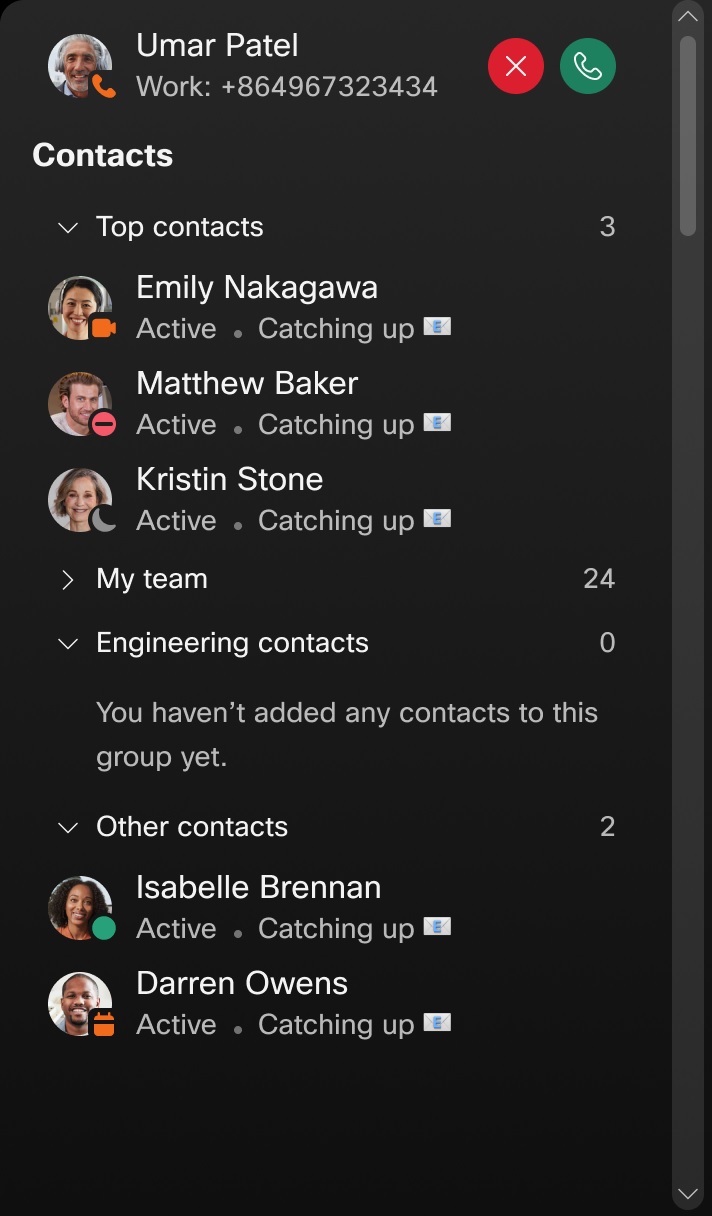
|
| 3 |
Click 
|
 shows how many voicemail messages you
have. You can listen to your messages at any time. You can also create a personal
greeting and customize your voicemail settings from Call
Settings.
shows how many voicemail messages you
have. You can listen to your messages at any time. You can also create a personal
greeting and customize your voicemail settings from Call
Settings.
|
Action |
What to do |
|---|---|
|
Listen to voicemail |
|
|
View voicemail actions |
Follow the voice prompts to mark a voicemail as confidential or urgent. |
|
View a transcript of your voicemail |
A transcript of the voicemail is displayed along with the options listed in the section View voicemail actions. You can view the transcript for each of your voicemails while you play the message. The client displays the voicemail transcripts if they are readily available on the server. The following statuses are available for the voicemail transcript:
|
You can manage your call settings, such as call forwarding, from settings.webex.com. Go to .
|
Action |
What to do |
|---|---|
|
View call setting options |
At the bottom left, click Call Settings. |
Click your profile picture in the left navigation bar to access your profile.
The following actions are available:
|
Action |
What to do |
|---|---|
|
Sign out |
Click Sign out to sign out of Webex Calling. |
|
Call settings |
Click Call Settings to access and manage call settings for your Webex Calling profile. |
You can get notifications for incoming calls while your calling application is in the background.
| 1 |
Click Close on your Webex Calling for Chrome client.
If you don't want this messge to be displayed again, check Don't show this again. |
| 2 |
Click Minimize Webex to keep the calling application in the background, or click Close Webex to close it. You won't receive notifications if you select Close Webex.
|
You can customize whether your Webex Calling for Chrome client asks for a confirmation before closing. If this option is enabled, after you click Close, you must confirm that you want to close Webex.
To configure the setting, follow these steps:
| 1 |
Right-click the Webex Calling for Chrome icon in your browser.
|
| 2 |
Click Options. Alternatively, go to Call Settings on your Webex Calling for Chrome client, then click Open Webex extension options. |
| 3 |
Toggle Ask before closing Webex on or off to set your preference. 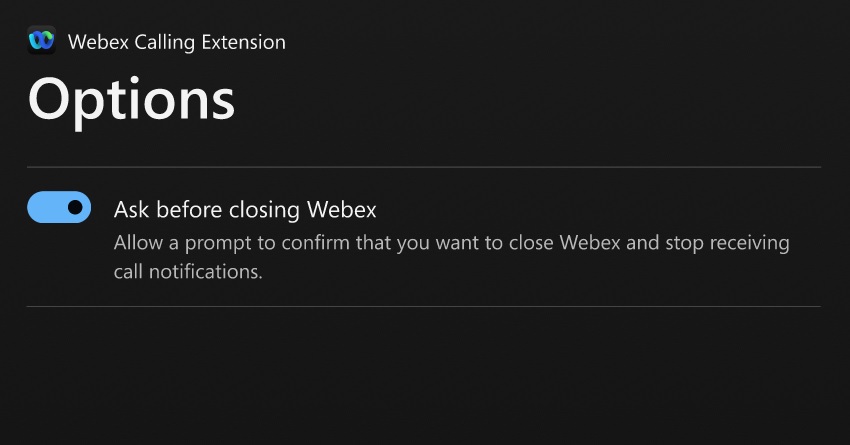
|
By default, softphone for a browser is enabled for all Webex Calling users with a Professional license.
To disable it, follow these steps:
| 1 |
Sign in to Control Hub, then select Users. |
| 2 |
Select a User. |
| 3 |
Go to . |
| 4 |
Uncheck Web to disable Webex Calling for Chrome for the selected user. As a Webex Calling administrator, you can use the Chrome Enterprise policy list to push the Webex Calling for Chrome extension remotely to the users' browser. For more information, see Understand Chrome policy management and Chrome Enterprise policy list. |

 to go to the voicemail screen.
to go to the voicemail screen. indicates the voicemail is
confidential or urgent. You can't forward a confidential
voicemail.
indicates the voicemail is
confidential or urgent. You can't forward a confidential
voicemail. to pause and resume the message
anytime.
to pause and resume the message
anytime. and select
and select 